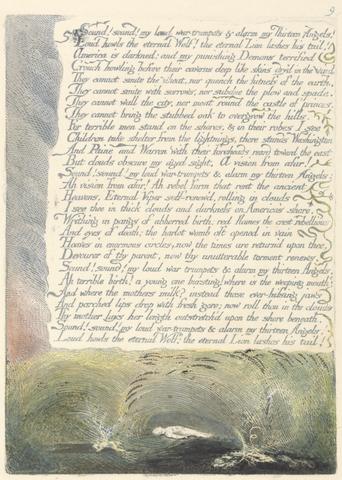Much has been written about Blake's relief engraving methods which
he developed to produce his 'illuminated books' which he first
mentioned in his Prospectus in 1793. He found that to produce fine
printed detail in his engraved plates he could add intaglio
techniques to supplement the relief etching. Of course the copper
plates which Blake engraved have disappeared, leaving only the paper
prints which were made from them. Scholars have studied the
resulting prints in attempting to learn how the images were
produced. The unique images which characterize Blake's work are the
result of his experimenting with existing methods, combining techniques
and trying things that hadn't been done before.
You may get some understanding of printing methods from observing
your own hands. The fine lines in your hand enable you to make types
of prints. If your hand is lightly covered with ink and pressed on
paper you can make a relief printing of the raised surfaces. If you covered
your hand heavily with ink and then wiped away the ink from the
raised surfaces you may with heavier pressure make an impression in
ink of the pattern of indented lines in your hand.
In the post Grain of Wheat, the image from 1804, depended solely on
white-line engraving to produce the lighted image of Los entering
the darkness of the void. In the post Woodcut on Pewter, the 1800
image on pewter was created by similar intaglio engraving which
Blake himself described. The lettering was produced by relief
etching supposedly on separate plates. Blake had used white line
etching earlier in his book America. Erdman tells us that
plates 2, 6, 8, 11, and 13 show the use of white-line as well as
relief etching.
 |
| Yale Center for British Art America Plate 11, Copy M |
| British Museum America Plate 11, Copy A |
Plate 11 is the most dramatic example of white-line etching in America.
It is clear that the effect of individual stalks of wheat could not
have been produced by Blake's relief method. In order to produce the
cocoon-like enclosure structure around the child with its delicate
threads, Blake was impelled to complicate his printing method by
adding intaglio engraving. Blake added coloring to some copies of
his white-line engravings producing striking results.
Miscellaneous Prose, Prospectus, (E 692)
"TO THE PUBLIC
October 10, 1793.
The Labours of the Artist, the Poet, the Musician, have been
proverbially attended by poverty and obscurity; this was never
the fault of the Public, but was owing to a neglect of means to
propagate such works as have wholly absorbed the Man of Genius.
Even Milton and Shakespeare could not publish their own works.
This difficulty has been obviated by the Author of the
following productions now presented to the Public; who has
invented a method of Printing both Letter-press and Engraving in
a style more ornamental, uniform, and grand, than any before
discovered, while it produces works at less than one fourth of
the expense.
If a method of Printing which combines the Painter and the
Poet is a phenomenon worthy of public attention, provided that it
exceeds in elegance all former methods, the Author is sure of his
reward.
Mr. Blake's powers of invention very early engaged the
attention of many persons of eminence and fortune; by whose means
he has been regularly enabled to bring before the Public works
(he is not afraid to say) of equal magnitude and consequence with
the productions of any age or country: among which are two large
highly finished engravings (and two more are nearly ready) which
will commence a Series of subjects from the Bible, and another
from the History of England.
The following are the Subjects of the several Works now
published and on Sale at Mr. Blake's, No. 13, Hercules Buildings,
Lambeth.
1. Job, a Historical Engraving. Size 1 ft.7 1/2 in. by 1
ft. 2 in.: price 12s.
2. Edward and Elinor, a Historical Engraving. Size 1 ft. 6
1/2 in. by 1 ft.: price 10s. 6d.
3. America, a Prophecy, in Illuminated Printing. Folio,
with 18 designs: price 10s. 6d.
4. Visions of the Daughters of Albion, in Illuminated
Printing. Folio, with 8 designs, price 7s. 6d.
5. The Book of Thel, a Poem in Illuminated Printing.
Quarto, with 6 designs, price 3s.
6. The Marriage of Heaven and Hell, in Illuminated
Printing. Quarto, with 14 designs, price 7s. 6d.
7. Songs of Innocence, in Illuminated Printing. Octavo,
with 25 designs, price 5s.
8. Songs of Experience, in Illuminated Printing. Octavo,
with 25 designs, price 5s.
9. The History of England, a small book of Engravings.
Price 3s.
10. The Gates of Paradise, a small book of Engravings.
Price 3s.
The Illuminated Books are Printed in Colours, and on the
most beautiful wove paper that
could be procured,
No Subscriptions for the numerous great works now in hand
are asked, for none are wanted; but the Author will produce his
works, and offer them to sale at a fair price."
Other examples of images which utilize white-line engraving include:
Approach of Doom after drawing by Robert Blake, 1788,
Death's Door for Blair's The Grave, 1805,
Man Sweeping the Interpreters Parlor, 1822.
No comments:
Post a Comment